Finally back in Tokyo. Flights all on time, landed early at 7.30am on a Friday; only problem was that Customs decided to search everything, don’t know why this knackered looking tourist got pulled. Mind you, he was a very nice Customs official and carefully repacked my rucksack. They could teach Saudi Customs a thing or two, you have to chase your underwear up the moving carousel as they chuck it on!
Eventually got the train into Tokyo, though I fell asleep at some point and only woke up when it was just departing for its return trip to the airport! Using my faithful GPS, more of this later, I soon found my Ryokan, a very nice place, complete with tatami mat with nice futon and kettle with tea just 15 mins walk away from Ueno Station. I dumped my bag and followed the sound of drums to the Nezu temple, just in time for Taiko drumming and a big parade – well that kept me awake and the jet-lag at bay!
Had a wander in the park and found a supermarket so I won’t starve. It’s over 80 degrees and sunny now, early May. I met up with my Japanese friend Hanae one evening, and we had a wander round Ueno market. She showed me stuff I wouldn’t have had a clue about, such as whole legs of octopus for example. We went to a local coffee shop for a long chat and catch up. My friend’s husband is a travel writer, and was not able to join us because he was in PNG!
Then I took the train to Kamakura, a very nice place, though by 2pm, jet-lag was catching up on me. Kamakura is on a peninsula south of Tokyo and Yokohama.
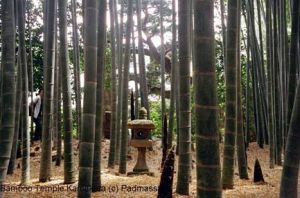 In Kamakura, I visited the Bamboo temple that my Tokyo friend told me about, set in a grove of bamboo, with monks chanting and green tea served in the garden. After this, I visited the giant Buddha, which used to be in a building until a tsunami removed them.
In Kamakura, I visited the Bamboo temple that my Tokyo friend told me about, set in a grove of bamboo, with monks chanting and green tea served in the garden. After this, I visited the giant Buddha, which used to be in a building until a tsunami removed them.
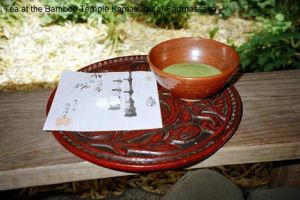 From Kamakura, I went to Enoshima island which is near Kamakura. It takes about an hour on the train from Tokyo. Enoshima was fun and tried to do a geocache, but there were too many people about and too much rubbish around as well, so went back to Tokyo.
From Kamakura, I went to Enoshima island which is near Kamakura. It takes about an hour on the train from Tokyo. Enoshima was fun and tried to do a geocache, but there were too many people about and too much rubbish around as well, so went back to Tokyo.
For my next trip, I took the train from Tokyo to Yamagata which takes about 3 hours including train hopping at Fukushima. To do this, I took the Shinkansen (Bullet train), super quick up to Fukushima where the train split in half. Needless to say, I was in the wrong half that was heading for Sendai so I had to get off and leg it onto the half continuing on to Yamadera, phew!!!
Yamadera is a lovely place, very friendly and the ryokan was only 4400 yen/night (about £20.). Went for wander to the castle and had a picnic in the park, found some of my favourite “Pea crips” in Daiei (Giant department store with good food place underneath) yum. I love looking round the “100 Yen shop”, they have all kinds of stuff in them. I went round a supermarket and saw “Wanko noodles” – I gave them a miss.
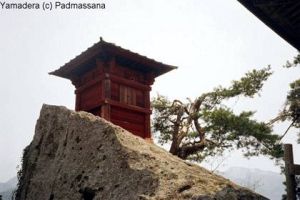 Another trip I made was taking the bus to Mt Zao, which despite being only 10 miles away took 90 mins to get to, thanks to the winding mountain roads and switchback hairpins. It was worth the ride to see Okama, a massive volcanic lake, fantastic place, you get to it via a chair lift. Loads of snow still, which you have to slip and slide through. Then walked up to Mt Kattadate over 5,000ft, spectacular views. Bought a mini bell for my rucksack. The Japanese all have them, they are to scare off bears!
Another trip I made was taking the bus to Mt Zao, which despite being only 10 miles away took 90 mins to get to, thanks to the winding mountain roads and switchback hairpins. It was worth the ride to see Okama, a massive volcanic lake, fantastic place, you get to it via a chair lift. Loads of snow still, which you have to slip and slide through. Then walked up to Mt Kattadate over 5,000ft, spectacular views. Bought a mini bell for my rucksack. The Japanese all have them, they are to scare off bears!
Then went to Yamadera to visit Basho, a place with little temples up a hill, it looks lovely in the guidebook. Yamadera is very touristy and should be known as Basho theme park. There are lovely temples up a mountain, over 1000 steps to the top, but what a view. Went to the Basho museum which has some of his calligraphy, quite interesting, but little in English.
Went to Tendo, a place is famous for making Shogi pieces for Japanese chess, quite an interesting museum and they gave me a nice book with it all in English.
Then visited Sendai primarily to visit Matsushima. Matsushima itself far too expensive to stay in, but with my rail pass an easy hit for daytrips from Sendai, also hope to do geocache in Sendai. I booked all of my accommodation on my trip on the internet as I went along.
Arrived in Sendai with a stinking cold and started looking for Ryokan Iwai, but got a bit lost in the vicinity when a little old lady asked me what I was looking for, luckily she used to work there and literally lead me by the hand and pointed it out across the street and insisted I wait for the green man at the crossing!
Went out to explore Sendai, a very big busy place that has a kfc! Tried to do a geocache in the suburbs, found a huge black snake on the path, but thanks to my Bear scaring bell it went away.
I had a major experience at the Sumitomo bank to change some Yen travellers cheques, what a palaver. The teller eventually gave me a form in Japanese for me to fill in, um yeah, right! So she then pointed at each square and wrote on a bit of paper what I had to write in each box! Why she couldn’t just fill it in and get me to sign it?
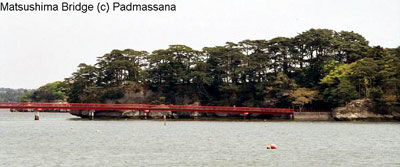 Eventually got the train to Hon Shiogama, this was in order to take the scenic boat trip to Matsushima (1400Yen). Nice 50 min ride through all the little islands, though absolutely freezing there and very windy.
Eventually got the train to Hon Shiogama, this was in order to take the scenic boat trip to Matsushima (1400Yen). Nice 50 min ride through all the little islands, though absolutely freezing there and very windy.
Eventually got to Matsushima and explored the big temple, but not fun in the driving rain. Then decided to head north to Morioka after talking to a Kiwi couple. Sado-ga Island would have been nice to visit, but with only local trains crossing Honshu this would mean 2 days of travelling, I get better value for my rail pass to go to Morioka, and from there I can go to Miyako on the coast and Kakunodate Samurai houses from there.
Most of my Ryokan arrivals have both been done via my knowledge of numbers 1 to 5 in Japanese and sleep mime signs! They bring out calculator and show me the price. Apart from a Kiwi couple, I have not seen a non Japanese person, unlike Tokyo, where there are lots of foreigners. That said, everyone without exception is helpful and friendly, things may take time like the bank, but I get there in the end.
This trip I have tried to move less, i.e. pick places where I can stay but can get to other places, such as Yamagata which was great for Zao and Yamadera as well as Yamagata itself. Sendai was perfect for Matsushima and from Morioka I can hit Miyako, Kokonodate, Mt Iwata and then back to Tokyo. I really want to see Mt Fuji this time, just got to pray for a clear day.
The sun shone the day I made it to Morioka from Sendai to Morioka on the bullet train. They go so fast you can’t read station names of places you pass and it’s too fast for GPS as well, I tried it! They are very quiet though.
I love travelling alone, you get to talk to more people even if it is through sign language. However just had a nice chat in English with Tourist office, think the girl enjoyed using her English. She told me to visit Miyako on the coast and Hirazumi for its temples. However Mt Iwata volcano still has 5 metres of snow so that one is out, she reckons the walking paths up there will not be open until end June or July.
When I left my Morioka Ryokan, all the people came to say goodbye and bowed as I left (I’m not worthy!) and gave me a little towel as a present for staying. Those are the things I li
ke a
bout Japan its efficiency and its friendliness.
Japanese geocaches either have proper Japanese translation underneath or the Japanese written in English letters. When you look at the logs for the caches some are in Japanese and some in English.

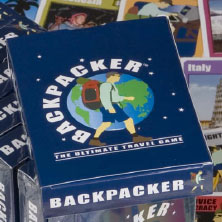 Backpacker – The Ultimate Travel Game is a card game in which you experience all the fun and unpredictability of travelling the world as you try to outwit your opponents to be the player who has returned home with the most photos. In Backpacker you visit different countries and continents, enjoy beaches, trekking, wildlife and culture, meet other travellers and get good and bad advice, whilst trying to avoid getting sick or missing your plane. You may even have to change your plans or seek assistance to cope with problems and delays, some of which may be caused by your fellow players. You need planning, good timing, patience and a bit of luck to win and with so many scenarios, no two games are ever the same. Just like travelling, it’s fun, exciting, fast-changing and very addictive.
Backpacker – The Ultimate Travel Game is a card game in which you experience all the fun and unpredictability of travelling the world as you try to outwit your opponents to be the player who has returned home with the most photos. In Backpacker you visit different countries and continents, enjoy beaches, trekking, wildlife and culture, meet other travellers and get good and bad advice, whilst trying to avoid getting sick or missing your plane. You may even have to change your plans or seek assistance to cope with problems and delays, some of which may be caused by your fellow players. You need planning, good timing, patience and a bit of luck to win and with so many scenarios, no two games are ever the same. Just like travelling, it’s fun, exciting, fast-changing and very addictive. In Kamakura, I visited the Bamboo temple that my Tokyo friend told me about, set in a grove of bamboo, with monks chanting and green tea served in the garden. After this, I visited the giant Buddha, which used to be in a building until a tsunami removed them.
In Kamakura, I visited the Bamboo temple that my Tokyo friend told me about, set in a grove of bamboo, with monks chanting and green tea served in the garden. After this, I visited the giant Buddha, which used to be in a building until a tsunami removed them.  From Kamakura, I went to Enoshima island which is near Kamakura. It takes about an hour on the train from Tokyo. Enoshima was fun and tried to do a geocache, but there were too many people about and too much rubbish around as well, so went back to Tokyo.
From Kamakura, I went to Enoshima island which is near Kamakura. It takes about an hour on the train from Tokyo. Enoshima was fun and tried to do a geocache, but there were too many people about and too much rubbish around as well, so went back to Tokyo. Another trip I made was taking the bus to Mt Zao, which despite being only 10 miles away took 90 mins to get to, thanks to the winding mountain roads and switchback hairpins. It was worth the ride to see Okama, a massive volcanic lake, fantastic place, you get to it via a chair lift. Loads of snow still, which you have to slip and slide through. Then walked up to Mt Kattadate over 5,000ft, spectacular views. Bought a mini bell for my rucksack. The Japanese all have them, they are to scare off bears!
Another trip I made was taking the bus to Mt Zao, which despite being only 10 miles away took 90 mins to get to, thanks to the winding mountain roads and switchback hairpins. It was worth the ride to see Okama, a massive volcanic lake, fantastic place, you get to it via a chair lift. Loads of snow still, which you have to slip and slide through. Then walked up to Mt Kattadate over 5,000ft, spectacular views. Bought a mini bell for my rucksack. The Japanese all have them, they are to scare off bears!  Eventually got the train to Hon Shiogama, this was in order to take the scenic boat trip to Matsushima (1400Yen). Nice 50 min ride through all the little islands, though absolutely freezing there and very windy.
Eventually got the train to Hon Shiogama, this was in order to take the scenic boat trip to Matsushima (1400Yen). Nice 50 min ride through all the little islands, though absolutely freezing there and very windy.  Ethnologists state that there are six broad hill tribe groupings: Karen, Lahu, Hmong, Lisu, Akha and Mien. Within these categories, there are sub-categories and clans that further divide the groups. Each hill tribe has its own customs, language, dress and spiritual beliefs and this is sometimes true even of the numerous sub-categories within one hill tribe. For example, the Green Hmong and White Hmong are said to speak in different and distinct dialects and dress differently.
Ethnologists state that there are six broad hill tribe groupings: Karen, Lahu, Hmong, Lisu, Akha and Mien. Within these categories, there are sub-categories and clans that further divide the groups. Each hill tribe has its own customs, language, dress and spiritual beliefs and this is sometimes true even of the numerous sub-categories within one hill tribe. For example, the Green Hmong and White Hmong are said to speak in different and distinct dialects and dress differently. 
 The main reason tourists come to visit the Paduang is because of the long-necked women. When the Beetle was in Thailand, she was told that the women in this tribe wore huge coils of metal around their necks to protect them from tigers. She asked if this tradition still held true and was assured that it did. What a load of nonsense! The women who wear these huge coils around their neck do so as a means of income generation from fees from tourists taking their photos and buying handicrafts presented at their stores. It came across, sadly, as something of a human freak show.
The main reason tourists come to visit the Paduang is because of the long-necked women. When the Beetle was in Thailand, she was told that the women in this tribe wore huge coils of metal around their necks to protect them from tigers. She asked if this tradition still held true and was assured that it did. What a load of nonsense! The women who wear these huge coils around their neck do so as a means of income generation from fees from tourists taking their photos and buying handicrafts presented at their stores. It came across, sadly, as something of a human freak show. down to the ankles.
down to the ankles. 
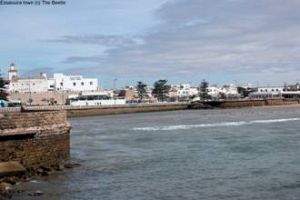 Essaouira is a charming seaside resort situated on the Atlantic Sea in Morocco. It has been a fishing village for centuries, but recently it has become a thriving tourism destination for those seeking a rest by the sea that is not Agadir, Morocco’s better busy and more commercialised known seaside resort.
Essaouira is a charming seaside resort situated on the Atlantic Sea in Morocco. It has been a fishing village for centuries, but recently it has become a thriving tourism destination for those seeking a rest by the sea that is not Agadir, Morocco’s better busy and more commercialised known seaside resort.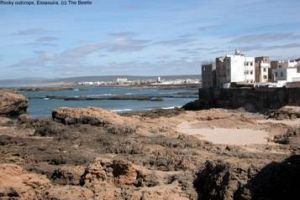 Essaouira is well connected by good roads – Marrakech is 175 km east, Safi 130 km north and Agadir 185 km to the south. Casablanca is 350 km north-east. It is a beautiful town with a mixture of Portuguese, French, and Berber architecture.
Essaouira is well connected by good roads – Marrakech is 175 km east, Safi 130 km north and Agadir 185 km to the south. Casablanca is 350 km north-east. It is a beautiful town with a mixture of Portuguese, French, and Berber architecture. 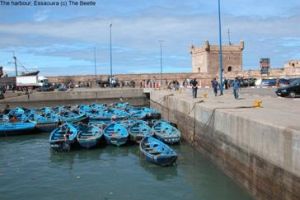
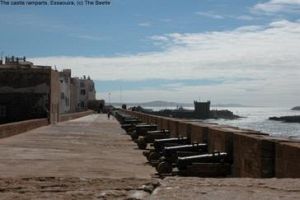

 Mac has not been very well but is still e-mailing strong. Here are some of Mac’s tales of travel to high altitudes and also an update on Stanley, one of Mac’s fellow residents of the Old Soldier’s home in Washington. Stanley belongs to an organisation that distributes eye glasses to those in less developed countries.
Mac has not been very well but is still e-mailing strong. Here are some of Mac’s tales of travel to high altitudes and also an update on Stanley, one of Mac’s fellow residents of the Old Soldier’s home in Washington. Stanley belongs to an organisation that distributes eye glasses to those in less developed countries.